以下内容主要参考了严蔚敏版的《数据结构》教材,但是教材里面只介绍了插入操作没有介绍删除操作,刚好在这篇文章里面有介绍删除操作且他好像也是参考严蔚敏版的《数据结构》教材里面的内容,因此我的删除操作主要参考于他这篇文章。
二叉树中的一个节点的平衡因子为其左子树的高度减去其右子树的高度的值。如果一颗二叉树中所有节点的平衡因子的绝对值都小于2则这颗二叉树是一颗平衡的二叉树,否则该二叉树是不平衡的。在这里我们同时假定这里的二叉树是二叉搜索树。平衡二叉搜索树和不平衡二叉搜索树的例子见图1。

如果首先不去理会二叉树的平衡性,则插入与删除操作就是二叉搜索树的插入与删除。对于插入操作,首先是在二叉树中查找有没有要插入的元素如果有则返回,不进行任何操作,如果没有则新建一节点并将该节点插入到某个节点(查找待插入元素时遇到的空节点父节点)的左孩子或右孩子。对于删除操作,如果二叉搜索树中不存在待删除的元素,则立即返回不做任何操作。如果待删除的元素在二叉搜索树中只有左子树或只有右子树,则将其左子树或右子树设为待删除的元素父节点的左子树或右子树(这要看待删除元素是其父节点的左孩子还是右孩子)。此种情况的例子见图2。

如果待删除节点既有左孩子又有右孩子,此时可以用在中序遍历中该节点的直接前驱或者直接后继替代该节点。如果是用其直接前驱替代该节点,则该直接前驱必定是该节点左子树中最右的节点,也是其左子树中值最大的节点且其右子树为空。替代完之后删除前驱节点即可,此时转换为删除只有左子树或只有右子树的节点的情况。如果是用其直接后继替代该节点,则该直接后继必定是该节点右子树中最左的节点,也是其左子树中值最小的节点且为叶子节点。替代完之后删除后继节点即可,此时转换为删除叶子节点的情况。此种情况的例子见图3。

如果待删除节点既有左孩子又有右孩子。若待删除节点为其父节点的左孩子,节点S为待删除节点在中序遍历序列中的直接前驱(节点S的右孩子为空),则可以将待删除节点的左子树设为其父节点的左子树,将待删除节点的右子树设为节点S的右子树。若待删除节点为其父节点的左孩子,节点S为待删除节点在中序遍历序列中的直接后继(节点S的左孩子为空),则可以将待删除节点的右子树设为其父节点的左子树,将待删除节点的左子树设为节点S的左子树。此种情况的例子见图4。若待删除节点为其父节点的右孩子,节点S为待删除节点在中序遍历序列中的直接后继(节点S的左孩子为空),则可以将待删除节点的右子树设为其父节点的右子树,将待删除节点的左子树设为节点S的左子树。若待删除节点为其父节点的右孩子,节点S为待删除节点在中序遍历序列中的直接前驱(节点S的右孩子为空),则可以将待删除节点的左子树设为其父节点的右子树,将待删除节点的右子树设为节点S的右子树。此种情况的例子见图5。

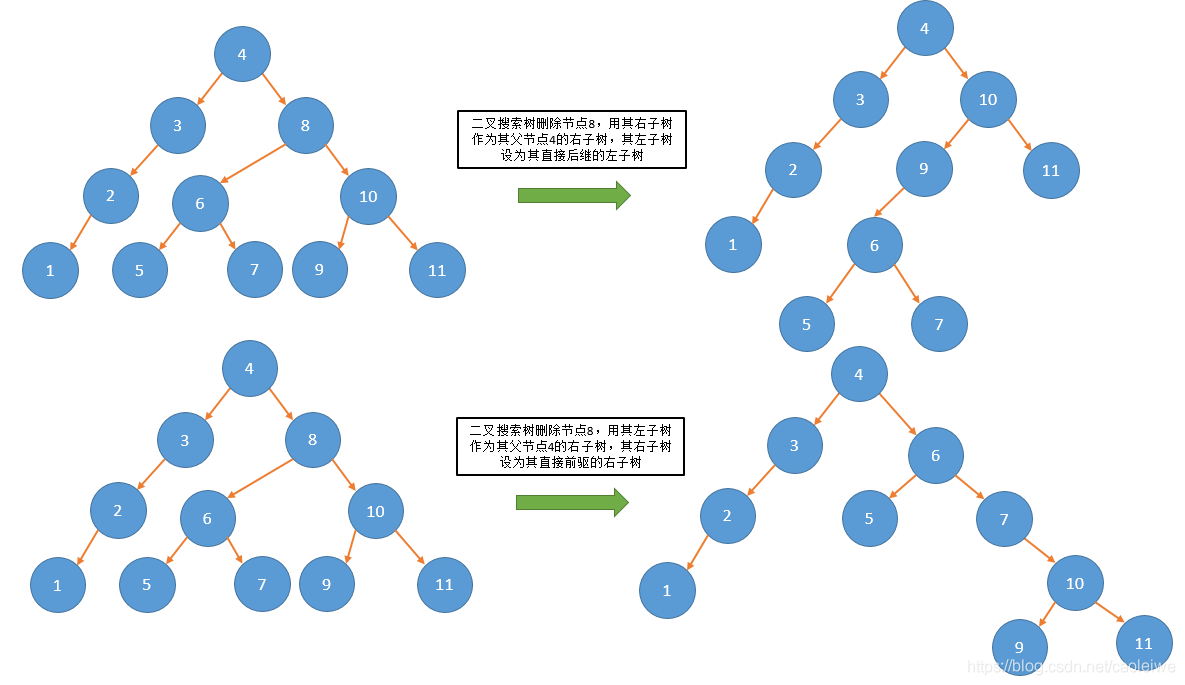
在以下平衡二叉搜索树删除算法的实现中,如果待删除节点既有左孩子又有右孩子,我们用在中序遍历中该节点的直接前驱替代该节点。
在平衡二叉搜索树中插入或删除节点后,如果没有改变平衡性则不必理会。如果出现不平衡的情况则必须进行调整使得其恢复平衡特性。假设由于在平衡二叉搜索树中插入节点D而失去平衡的最小子树根节点为A(即离插入节点D最近且平衡因子绝对值超过1的祖先节点),则失去平衡后进行调整的规律可以归纳为以下四种情况,分别如图6、7、8、9所示:
- 左平衡处理:单向右旋恢复平衡(在节点A的左孩子的左子树中插入节点使得以A为根节点的子树失去平衡)
- 左平衡处理:单向左旋+单向右旋恢复平衡(在节点A的左孩子的右子树中插入节点使得以A为根节点的子树失去平衡)
- 右平衡处理:单向左旋恢复平衡(在节点A的右孩子的右子树中插入节点使得以A为根节点的子树失去平衡)
- 右平衡处理:单向右旋+单向左旋恢复平衡(在节点A的右孩子的左子树中插入节点使得以A为根节点的子树失去平衡)
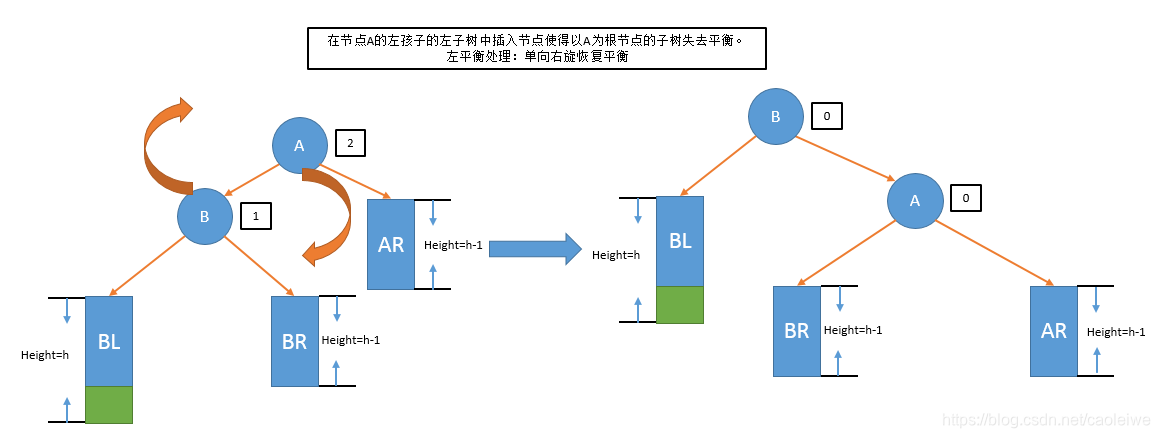
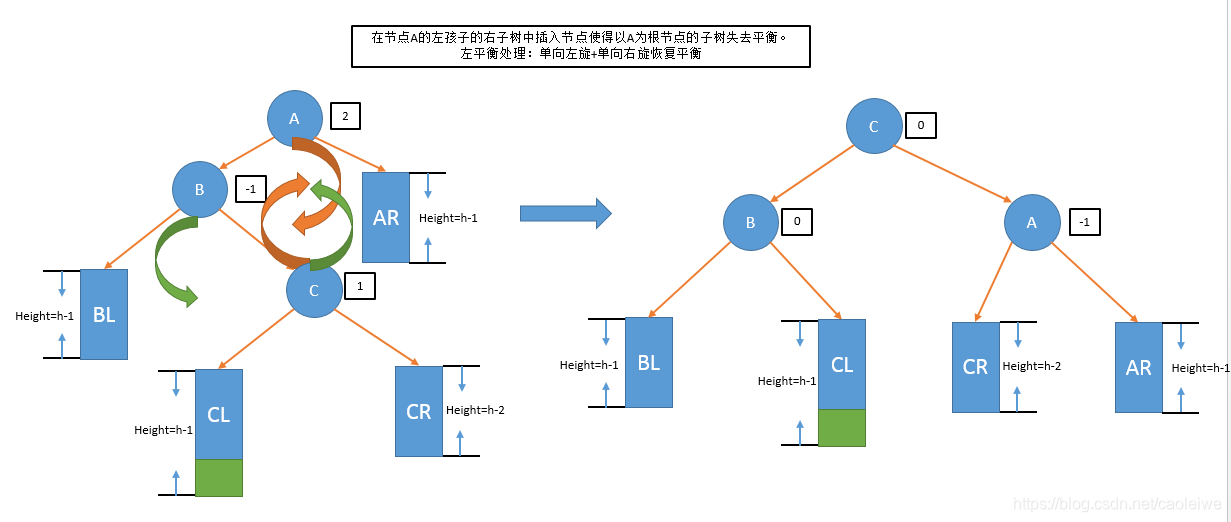
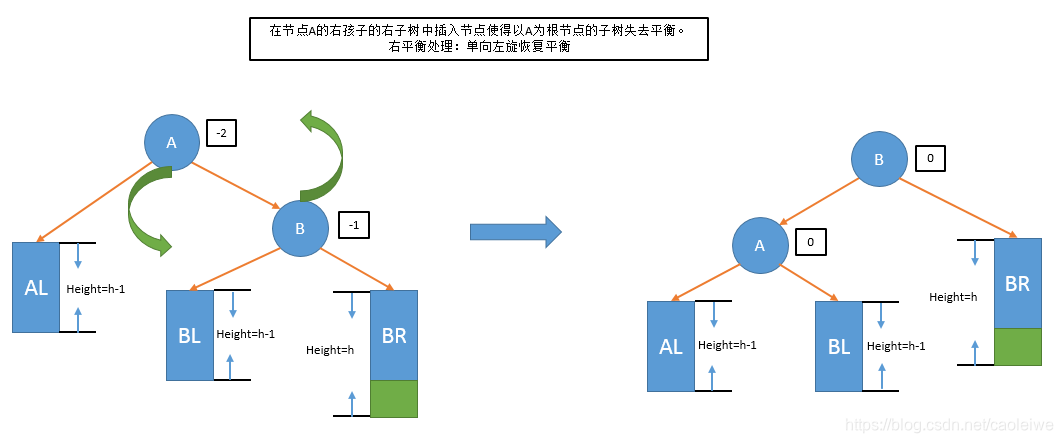
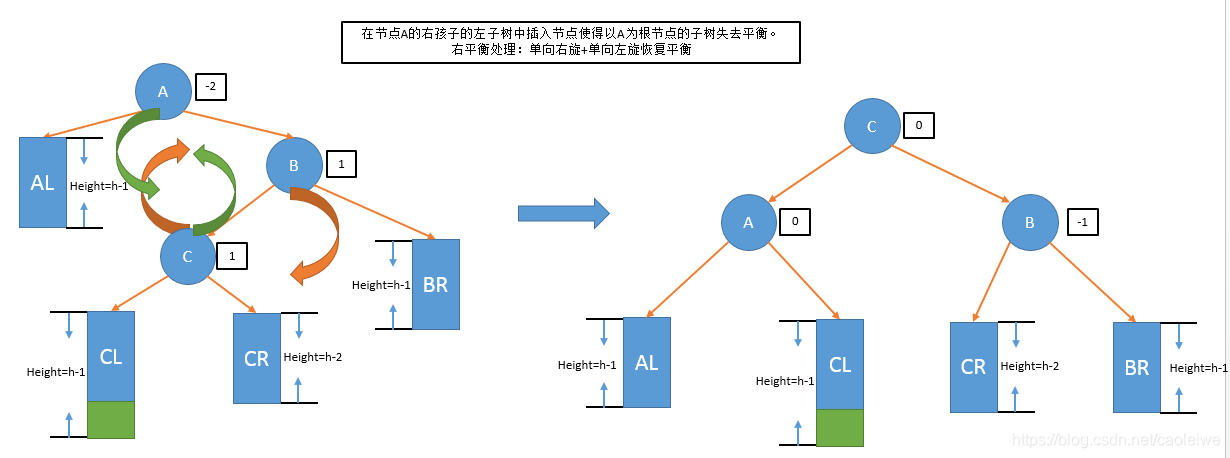
从以上操作可以看出一共有两种平衡处理(左平衡处理:在节点A的左子树中插入节点使得树不在平衡,右平衡处理:在节点A的右子树中插入节点使得树不再平衡,)以及两种旋转操作(左旋以及右旋)。两种平衡处理分别对应函数 B i n a r y S e a r c h N o d e ∗ l e f t B a l a n c e ( B i n a r y S e a r c h N o d e ∗ r o o t , B i n a r y S e a r c h N o d e ∗ f a t h e r ) BinarySearchNode* leftBalance(BinarySearchNode* root, BinarySearchNode* father) BinarySearchNode∗leftBalance(BinarySearchNode∗root,BinarySearchNode∗father)和 B i n a r y S e a r c h N o d e ∗ r i g h t B a l a n c e ( B i n a r y S e a r c h N o d e ∗ r o o t , B i n a r y S e a r c h N o d e ∗ f a t h e r ) BinarySearchNode* rightBalance(BinarySearchNode * root, BinarySearchNode * father) BinarySearchNode∗rightBalance(BinarySearchNode∗root,BinarySearchNode∗father),两种旋转操作分别对应函数 B i n a r y S e a r c h N o d e ∗ R _ R o t a t e ( B i n a r y S e a r c h N o d e ∗ r o o t , B i n a r y S e a r c h N o d e ∗ f a t h e r ) BinarySearchNode* R\_Rotate(BinarySearchNode* root, BinarySearchNode* father) BinarySearchNode∗R_Rotate(BinarySearchNode∗root,BinarySearchNode∗father)和 B i n a r y S e a r c h N o d e ∗ L _ R o t a t e ( B i n a r y S e a r c h N o d e ∗ r o o t , B i n a r y S e a r c h N o d e ∗ f a t h e r ) BinarySearchNode* L\_Rotate(BinarySearchNode* root, BinarySearchNode* father) BinarySearchNode∗L_Rotate(BinarySearchNode∗root,BinarySearchNode∗father)。对于具体的实现请看源码解释。
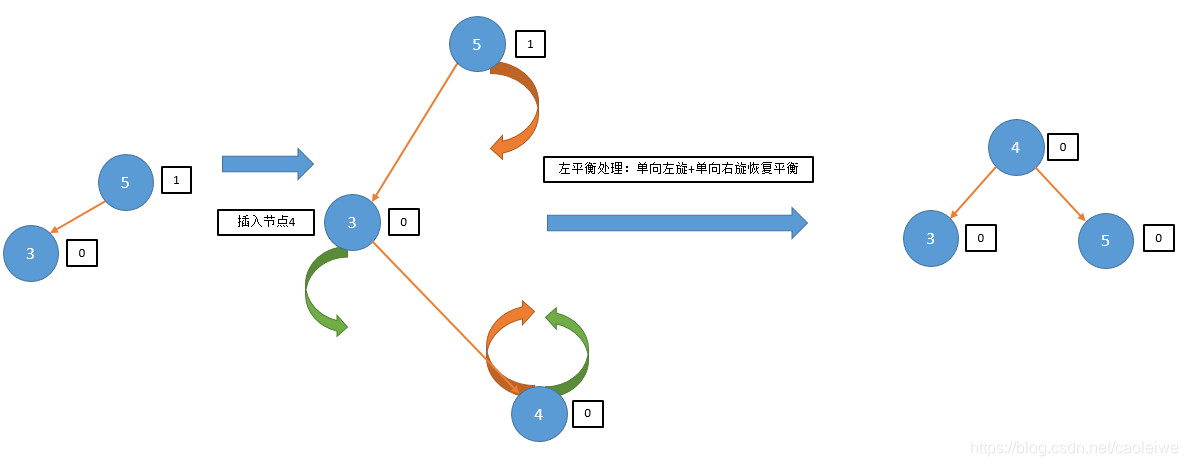

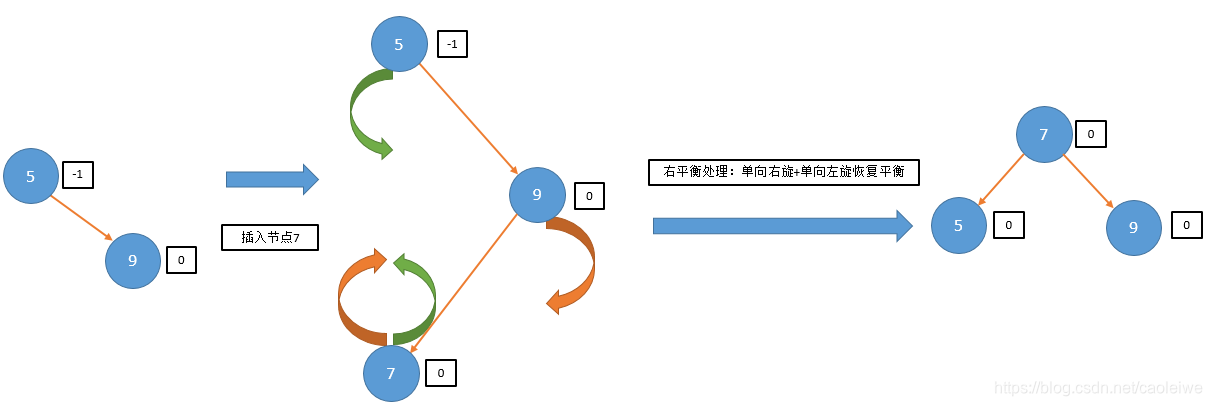
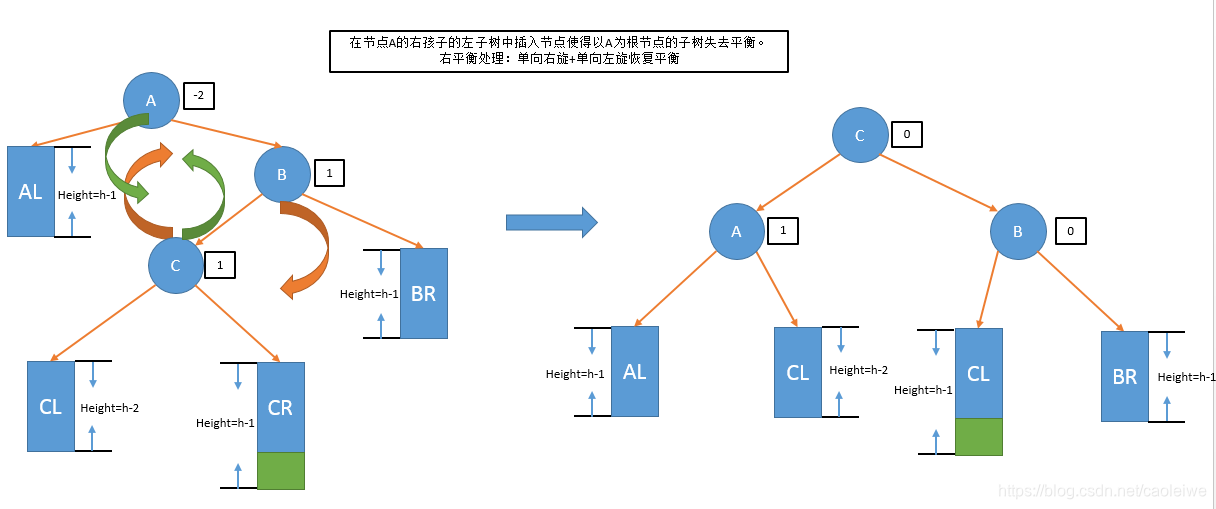


class BinarySearchNode
{
private:
int data;
int balanceFactor;
BinarySearchNode* left;
BinarySearchNode* right;
public:
BinarySearchNode(int d1 = 0, int d2 = 0)
{
data = d1;
balanceFactor = d2;//平衡因子:左子树的高度减去右子树的高度,如果该值为0、1或-1则以该节点为根的子树是平衡的否则是不平衡的。
left = nullptr;
right = nullptr;
}
BinarySearchNode* getLeft()
{
return left;
}
BinarySearchNode* getRight()
{
return right;
}
void setLeft(BinarySearchNode* value)
{
left = value;
}
void setRight(BinarySearchNode* value)
{
right = value;
}
int getData()
{
return data;
}
void setData(int value)
{
data = value;
}
int getBalanceFactor()
{
return balanceFactor;
}
void setBalanceFactor(int value)
{
balanceFactor = value;
}
};
void printBST(BinarySearchNode* root);
//右旋操作
//root可以考虑以上介绍的节点A,father为节点A的父节点
BinarySearchNode* R_Rotate(BinarySearchNode* root, BinarySearchNode* father)
{
BinarySearchNode* left = root->getLeft();
root->setLeft(left->getRight());
left->setRight(root);
if (father != nullptr)
{
if (left->getData() <= father->getData())
{
father->setLeft(left);
}
else
{
father->setRight(left);
}
return nullptr;
}
else
{
return left;
}
}
//左旋操作
//root可以考虑以上介绍的节点A,father为节点A的父节点
BinarySearchNode* L_Rotate(BinarySearchNode* root, BinarySearchNode* father)
{
BinarySearchNode* right = root->getRight();
root->setRight(right->getLeft());
right->setLeft(root);
if (father != nullptr)
{
if (right->getData() <= father->getData())
{
father->setLeft(right);
}
else
{
father->setRight(right);
}
return nullptr;
}
else
{
return right;
}
}
void printBST(BinarySearchNode* root)
{
if (root == nullptr)
{
return;
}
else
{
cout << "data=" << root->getData() << endl;
cout << "balanceFactor=" << root->getBalanceFactor() << endl;
}
printBST(root->getLeft());
printBST(root->getRight());
}
//左平衡处理
//root可以考虑以上介绍的节点A,father为节点A的父节点
BinarySearchNode* leftBalance(BinarySearchNode* root, BinarySearchNode* father)
{
BinarySearchNode* left = root->getLeft();
BinarySearchNode* right = left->getRight();
BinarySearchNode* newRoot = nullptr;
switch (left->getBalanceFactor())
{
case 1://对应图6的情况
root->setBalanceFactor(0);
left->setBalanceFactor(0);
newRoot = R_Rotate(root, father);
break;
case -1:
switch (right->getBalanceFactor())
{
case 1://对应图7的情况
root->setBalanceFactor(-1);
left->setBalanceFactor(0);
break;
case 0://对应图10的情况
root->setBalanceFactor(0);
left->setBalanceFactor(0);
break;
case -1://对应图11的情况
root->setBalanceFactor(0);
left->setBalanceFactor(1);
break;
}
right->setBalanceFactor(0);
L_Rotate(root->getLeft(), root);
newRoot = R_Rotate(root, father);
break;
case 0: //这种情况只在删除平衡二叉搜索树中的节点的情况下出现,不会在往平衡二叉搜索树中插入节点的情况下出现,并且在其中的旋转操作之后树的高度不变//对应图14的情况
left->setBalanceFactor(-1);
root->setBalanceFactor(1);
newRoot = R_Rotate(root, father);
break;
}
return newRoot;
}
//右平衡处理
//root可以考虑以上介绍的节点A,father为节点A的父节点
BinarySearchNode* rightBalance(BinarySearchNode * root, BinarySearchNode * father)
{
BinarySearchNode* right = root->getRight();
BinarySearchNode* left = right->getLeft();
BinarySearchNode* newRoot = nullptr;
switch (right->getBalanceFactor())
{
case -1://对应图8的情况
root->setBalanceFactor(0);
right->setBalanceFactor(0);
newRoot = L_Rotate(root, father);
break;
case 1:
switch (left->getBalanceFactor())
{
case 1://对应图9的情况
root->setBalanceFactor(0);
right->setBalanceFactor(-1);
break;
case 0://对应图12的情况
root->setBalanceFactor(0);
right->setBalanceFactor(0);
break;
case -1://对应图13的情况
root->setBalanceFactor(1);
right->setBalanceFactor(0);
break;
}
right->setBalanceFactor(0);
R_Rotate(root->getRight(), root);
newRoot = L_Rotate(root, father);
break;
case 0: 这种情况只在删除平衡二叉搜索树中的节点的情况下出现,不会在往平衡二叉搜索树中插入节点的情况下出现,并且在其中的旋转操作之后树的高度不变。具体可见example1
right->setBalanceFactor(1);
root->setBalanceFactor(-1);
newRoot = L_Rotate(root, father);
break;
}
return newRoot;
}
//平衡二叉搜索树的插入函数
//参数root为待插入的平衡二叉搜索树的根节点,参数father为待插入的平衡二叉搜索树的根节点的父节点(在首次调用时其为空指针),参数insertElement为待插入的元素,参数taller用来记录此次插入操作以root为根节点的树个高度是否增高, 如果在插入节点之后树的跟节点变为其它节点则参数newRoot记录新的树根。
int InsertAVL(BinarySearchNode * root, BinarySearchNode * father, int insertElement, bool& taller, BinarySearchNode * &newRoot)
{
if (root == nullptr) //如果为空则说明找到了插入位置并插入新的节点,参数taller设为true。
{
root = new BinarySearchNode(insertElement);
if (father != nullptr)
{
if (insertElement <= father->getData())
{
father->setLeft(root);
}
else
{
father->setRight(root);
}
newRoot = nullptr;
taller = true;
}
else
{
//如果father参数为空,则新插入的节点即为根节点
taller = true;
newRoot = root;
}
}
else
{
if (root->getData() == insertElement)
{
//如果在树中找到了同样的元素则返回什么都不做,return 0;表示没有插入元素。return 1;表示插入了元素。
taller = false;
newRoot = nullptr;
return 0;
}
else if (insertElement < root->getData())
{
//如果待插入元素小于当前节点的元素值则递归在左子树上插入
if (!InsertAVL(root->getLeft(), root, insertElement, taller, newRoot))
{
return 0;
}
if (taller)
{
//如果在左子树上插入一个节点并且左子树高度增加1
switch (root->getBalanceFactor())
{
case 1://如果当前根节点的平衡因子为1,则当前根节点的平衡因子为现在变为2需要进行左平衡处理。
newRoot = leftBalance(root, father);
taller = false;
break;
case 0://如果当前根节点的平衡因子为0,则当前根节点的平衡因子为现在变为1,则以当前根节点为根节点的子树高度增加。
root->setBalanceFactor(1);
taller = true;
break;
case -1://如果当前根节点的平衡因子为-1,则当前根节点的平衡因子为现在变为0,则以当前根节点为根节点的子树高度没有增加。
root->setBalanceFactor(0);
taller = false;
break;
}
}
}
else if (insertElement > root->getData())
{
//如果待插入元素大于当前节点的元素值则递归在右子树上插入
if (!InsertAVL(root->getRight(), root, insertElement, taller, newRoot))
{
return 0;
}
if (taller)
{
//如果在右子树上插入一个节点并且左子树高度增加1
switch (root->getBalanceFactor())
{
case 1://如果当前根节点的平衡因子为1,则当前根节点的平衡因子为现在变为0,则以当前根节点为根节点的子树高度没有增加。
root->setBalanceFactor(0);
taller = false;
break;
case 0://如果当前根节点的平衡因子为0,则当前根节点的平衡因子为现在变为-1,则以当前根节点为根节点的子树高度增加。
root->setBalanceFactor(-1);
taller = true;
break;
case -1://如果当前根节点的平衡因子为-1,则当前根节点的平衡因子为现在变为-2需要进行右平衡处理。
newRoot = rightBalance(root, father);
taller = false;
break;
}
}
}
}
return 1;
}
//平衡二叉搜索树的删除函数
//参数root为待删除的平衡二叉搜索树的根节点,参数father为待删除的平衡二叉搜索树的根节点的父节点(在首次调用时其为空指针),参数deleteElement为待删除的元素,参数shorter用来记录此次删除操作以root为根节点的树个高度是否降低, 如果在删除节点之后树的根节点变为其它节点则参数newRoot记录新的树根。
int DeleteAVL(BinarySearchNode * root, BinarySearchNode * father, int deleteElement, bool& shorter, BinarySearchNode * &newRoot)
{
if (root == nullptr)
{
//树为空树,没有任何操作
shorter = false;
newRoot = nullptr;
return 0;
}
else
{
if (root->getData() == deleteElement)
{
//如果找到待删除节点
if (root->getLeft() == nullptr)
{
//如果待删除节点的左子树为空
if (father != nullptr)
{
if (deleteElement <= father->getData())
{
father->setLeft(root->getRight());
free(root);
}
else
{
father->setRight(root->getRight());
free(root);
}
newRoot = nullptr;
}
else
{
newRoot = root->getRight();
free(root);
}
shorter = true;
}
else if (root->getRight() == nullptr)
{
//如果待删除节点的右子树为空
if (father != nullptr)
{
if (deleteElement <= father->getData())
{
father->setLeft(root->getLeft());
free(root);
}
else
{
father->setRight(root->getLeft());
free(root);
}
newRoot = nullptr;
}
else
{
newRoot = root->getLeft();
free(root);
}
shorter = true;
}
else
{
//如果待删除节点的左右子树均不为空
BinarySearchNode* q = root;
BinarySearchNode* s = root->getLeft();
//找到待删除节点的直接前驱节点
while (s->getRight() != nullptr)
{
q = s;
s = s->getRight();
}
root->setData(s->getData());
/
//注意这里不要直接使用下面这段代码来执行删除操作,因为此时待删除节点的左右子树均不为空。如果直接使用下面这段代码执行删除操作的话会造成待删除节点的直接前驱节点到待删除节点之间的节点的平衡因子没有更新,在某些情况下操作完之后树是平衡的,但是某些节点的平衡因子是错的,这样会导致下次删除或插入操作的错误。
//if (q != root)
//{
// q->setRight(s->getLeft());
//}
//else
//{
// q->setLeft(s->getLeft());
//}
//free(s);
/
//所以这里用待删除节点的直接前驱替代待删除节点之后,相当于在待删除节点的左子树中递归删除以前待删除节点的直接前驱节点。
if (!DeleteAVL(root->getLeft(), root, s->getData(), shorter, newRoot))
{
return 0;
}
if (shorter)
{
switch (root->getBalanceFactor())
{
case 1:
root->setBalanceFactor(0);
shorter = true;
break;
case 0:
root->setBalanceFactor(-1);
shorter = false;
break;
case -1:
if (root->getRight()->getBalanceFactor() == 0)
shorter = false;
else
shorter = true;
newRoot = rightBalance(root, father);
break;
}
}
}
}
else if (deleteElement < root->getData())
{
//如果待删除元素小于当前节点元素的值则递归的在其左子树中删除
if (!DeleteAVL(root->getLeft(), root, deleteElement, shorter, newRoot))
{
return 0;
}
//如果在左子树上删除一个节点并且左子树高度减1
if (shorter)
{
switch (root->getBalanceFactor())
{
case 1:
//如果当前根节点的平衡因子为1,则当前根节点的平衡因子为现在变为0,则以当前根节点为根节点的子树高度减1。
root->setBalanceFactor(0);
shorter = true;
break;
case 0:
//如果当前根节点的平衡因子为0,则当前根节点的平衡因子为现在变为-1,则以当前根节点为根节点的子树高度不变。
root->setBalanceFactor(-1);
shorter = false;
break;
case -1:
//如果当前根节点的平衡因子为-1,则当前根节点的平衡因子为现在变为-2,需要进行右平衡处理。
if (root->getRight()->getBalanceFactor() == 0)
shorter = false;//对example1的情况
else
shorter = true;//对example2的情况
newRoot = rightBalance(root, father);
break;
}
}
}
else if (deleteElement > root->getData())
{
//如果待删除元素大于当前节点元素的值则递归的在其右子树中删除
if (!DeleteAVL(root->getRight(), root, deleteElement, shorter, newRoot))
{
return 0;
}
if (shorter)
{
//如果在右子树上删除一个节点并且左子树高度减1
switch (root->getBalanceFactor())
{
case 1:
//如果当前根节点的平衡因子为1,则当前根节点的平衡因子为现在变为2,需要进行左平衡处理。
if (root->getLeft()->getBalanceFactor() == 0)
shorter = false;//对应图14的情况
else
shorter = true;//对应图15的情况
newRoot = leftBalance(root, father);
break;
case 0:
//如果当前根节点的平衡因子为0,则当前根节点的平衡因子为现在变为1,则以当前根节点为根节点的子树高度不变。
root->setBalanceFactor(1);
shorter = false;
break;
case -1:
//如果当前根节点的平衡因子为-1,则当前根节点的平衡因子为现在变为0,则以当前根节点为根节点的子树高度减1。
root->setBalanceFactor(0);
shorter = true;
break;
}
}
}
}
return 1;
}
下面放几个简单的例子测试一下插入和删除操作。



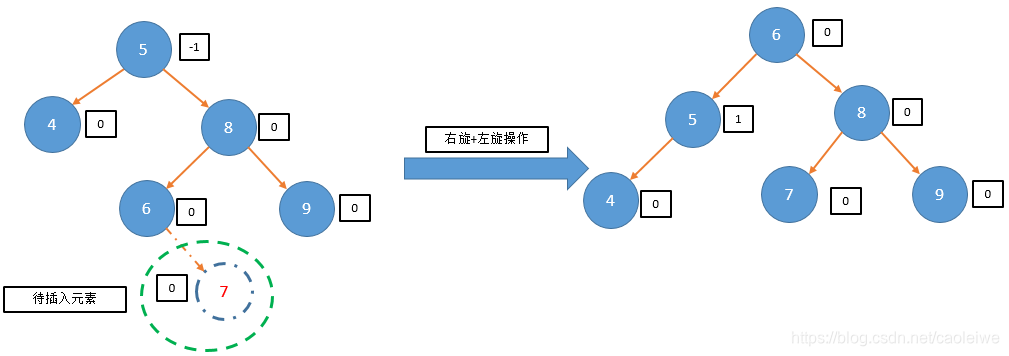



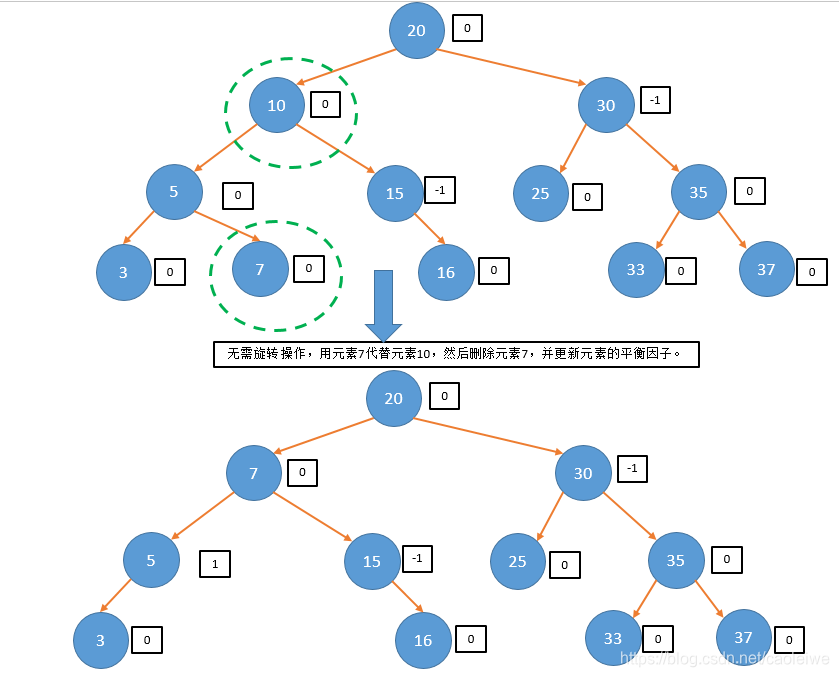
//测试程序
int main()
{
int status = 0;
cout << "===================example1==============================" << endl;
bool shorter1 = false;
BinarySearchNode* newRoot1 = nullptr;
BinarySearchNode* root1 = new BinarySearchNode(5,-1);
BinarySearchNode* root1OfNode4 = new BinarySearchNode(4, 0);
BinarySearchNode* root1OfNode7 = new BinarySearchNode(7, 0);
BinarySearchNode* root1OfNode6 = new BinarySearchNode(6, 0);
BinarySearchNode* root1OfNode8 = new BinarySearchNode(8, 0);
root1->setLeft(root1OfNode4);
root1->setRight(root1OfNode7);
root1OfNode7->setLeft(root1OfNode6);
root1OfNode7->setRight(root1OfNode8);
cout << "Original tree is:" << endl;
printBST(root1);
status = DeleteAVL(root1,nullptr,4,shorter1,newRoot1);
cout << "Return status=" << status << endl;
cout << "The tree after deletion operation is:" << endl;
if (newRoot1 != nullptr)
{
printBST(newRoot1);
}
else
{
printBST(root1);
}
cout << "===================example2==============================" << endl;
bool shorter2 = false;
BinarySearchNode* newRoot2 = nullptr;
BinarySearchNode* root2 = new BinarySearchNode(5, -1);
BinarySearchNode * root2OfNode4 = new BinarySearchNode(4, 0);
BinarySearchNode * root2OfNode7 = new BinarySearchNode(7, 1);
BinarySearchNode * root2OfNode6 = new BinarySearchNode(6, 0);
root2->setLeft(root2OfNode4);
root2->setRight(root2OfNode7);
root2OfNode7->setLeft(root2OfNode6);
cout << "Original tree is:" << endl;
printBST(root2);
status = DeleteAVL(root2, nullptr, 4, shorter2, newRoot2);
cout << "Return status=" << status << endl;
cout << "The tree after deletion operation is:" << endl;
if (newRoot2 != nullptr)
{
printBST(newRoot2);
}
else
{
printBST(root2);
}
cout << "===================example3==============================" << endl;
bool shorter3 = false;
BinarySearchNode* newRoot3 = nullptr;
BinarySearchNode* root3 = new BinarySearchNode(10, 1);
BinarySearchNode* root3OfNode11 = new BinarySearchNode(11, -1);
BinarySearchNode* root3OfNode12 = new BinarySearchNode(12, 0);
BinarySearchNode* root3OfNode5 = new BinarySearchNode(5, -1);
BinarySearchNode * root3OfNode4 = new BinarySearchNode(4, 0);
BinarySearchNode * root3OfNode7 = new BinarySearchNode(7, -1);
BinarySearchNode * root3OfNode8 = new BinarySearchNode(8, 0);
root3->setLeft(root3OfNode5);
root3->setRight(root3OfNode11);
root3OfNode5->setLeft(root3OfNode4);
root3OfNode5->setRight(root3OfNode7);
root3OfNode7->setRight(root3OfNode8);
root3OfNode11->setRight(root3OfNode12);
cout << "Original tree is:" << endl;
printBST(root3);
status = DeleteAVL(root3, nullptr, 4, shorter3, newRoot3);
cout << "The tree after deletion operation is:" << endl;
cout << "Return status=" << status << endl;
if (newRoot3 != nullptr)
{
printBST(newRoot3);
}
else
{
printBST(root3);
}
cout << "===================example4==============================" << endl;
bool taller1 = false;
BinarySearchNode* newRoot4 = nullptr;
BinarySearchNode* root4 = new BinarySearchNode(5, -1);
BinarySearchNode * root4OfNode4 = new BinarySearchNode(4, 0);
BinarySearchNode * root4OfNode9 = new BinarySearchNode(9, 0);
BinarySearchNode * root4OfNode6 = new BinarySearchNode(6, 0);
BinarySearchNode * root4OfNode8 = new BinarySearchNode(8, 0);
root4->setLeft(root4OfNode4);
root4->setRight(root4OfNode8);
root4OfNode8->setLeft(root4OfNode6);
root4OfNode8->setRight(root4OfNode9);
cout << "Original tree is:" << endl;
printBST(root4);
status = InsertAVL(root4, nullptr, 7, taller1, newRoot4);
cout << "The tree after insertion operation is:" << endl;
cout << "Return status=" << status << endl;
if (newRoot4 != nullptr)
{
printBST(newRoot4);
}
else
{
printBST(root4);
}
cout << "===================example5==============================" << endl;
bool taller2 = false;
BinarySearchNode* newroot5 = nullptr;
BinarySearchNode* root5 = new BinarySearchNode(5, -1);
BinarySearchNode * root5OfNode4 = new BinarySearchNode(4, 0);
BinarySearchNode * root5OfNode9 = new BinarySearchNode(9, 0);
BinarySearchNode * root5OfNode6 = new BinarySearchNode(6, 0);
BinarySearchNode * root5OfNode8 = new BinarySearchNode(8, 0);
root5->setLeft(root5OfNode4);
root5->setRight(root5OfNode8);
root5OfNode8->setLeft(root5OfNode6);
root5OfNode8->setRight(root5OfNode9);
cout << "Original tree is:" << endl;
printBST(root5);
status = InsertAVL(root5, nullptr, 10, taller2, newroot5);
cout << "The tree after insertion operation is:" << endl;
cout << "Return status=" << status << endl;
if (newroot5 != nullptr)
{
printBST(newroot5);
}
else
{
printBST(root5);
}
cout << "===================example6==============================" << endl;
bool taller3 = false;
BinarySearchNode* newroot6 = nullptr;
BinarySearchNode* root6 = new BinarySearchNode(6, 1);
BinarySearchNode* root6OfNode3 = new BinarySearchNode(3, 0);
BinarySearchNode* root6OfNode7 = new BinarySearchNode(7, 0);
BinarySearchNode* root6OfNode2 = new BinarySearchNode(2, 0);
BinarySearchNode* root6OfNode4 = new BinarySearchNode(4, 0);
root6->setLeft(root6OfNode3);
root6->setRight(root6OfNode7);
root6OfNode3->setLeft(root6OfNode2);
root6OfNode3->setRight(root6OfNode4);
cout << "Original tree is:" << endl;
printBST(root6);
status = InsertAVL(root6, nullptr, 1, taller3, newroot6);
cout << "The tree after insertion operation is:" << endl;
cout << "Return status=" << status << endl;
if (newroot6 != nullptr)
{
printBST(newroot6);
}
else
{
printBST(root6);
}
cout << "===================example7==============================" << endl;
bool taller4 = false;
BinarySearchNode* newroot7 = nullptr;
BinarySearchNode* root7 = new BinarySearchNode(6, 1);
BinarySearchNode* root7OfNode3 = new BinarySearchNode(3, 0);
BinarySearchNode* root7OfNode7 = new BinarySearchNode(7, 0);
BinarySearchNode* root7OfNode2 = new BinarySearchNode(2, 0);
BinarySearchNode* root7OfNode4 = new BinarySearchNode(4, 0);
root7->setLeft(root7OfNode3);
root7->setRight(root7OfNode7);
root7OfNode3->setLeft(root7OfNode2);
root7OfNode3->setRight(root7OfNode4);
cout << "Original tree is:" << endl;
printBST(root7);
status = InsertAVL(root7, nullptr, 5, taller3, newroot7);
cout << "The tree after insertion operation is:" << endl;
cout << "Return status=" << status << endl;
if (newroot7 != nullptr)
{
printBST(newroot7);
}
else
{
printBST(root7);
}
cout << "===================example8==============================" << endl;
bool shorter4 = false;
BinarySearchNode* newroot8 = nullptr;
BinarySearchNode* root8 = new BinarySearchNode(20, 0);
BinarySearchNode* root8OfNode10 = new BinarySearchNode(10, 0);
BinarySearchNode* root8OfNode30 = new BinarySearchNode(30, -1);
BinarySearchNode* root8OfNode5 = new BinarySearchNode(5, 0);
BinarySearchNode* root8OfNode15 = new BinarySearchNode(15, -1);
BinarySearchNode* root8OfNode25 = new BinarySearchNode(25, 0);
BinarySearchNode* root8OfNode35 = new BinarySearchNode(35, 0);
BinarySearchNode* root8OfNode3 = new BinarySearchNode(3, 0);
BinarySearchNode* root8OfNode7 = new BinarySearchNode(7, 0);
BinarySearchNode* root8OfNode16 = new BinarySearchNode(16, 0);
BinarySearchNode* root8OfNode33 = new BinarySearchNode(33, 0);
BinarySearchNode* root8OfNode37 = new BinarySearchNode(37, 0);
root8->setLeft(root8OfNode10);
root8->setRight(root8OfNode30);
root8OfNode10->setLeft(root8OfNode5);
root8OfNode10->setRight(root8OfNode15);
root8OfNode30->setLeft(root8OfNode25);
root8OfNode30->setRight(root8OfNode35);
root8OfNode5->setLeft(root8OfNode3);
root8OfNode5->setRight(root8OfNode7);
root8OfNode15->setLeft(root8OfNode16);
root8OfNode35->setLeft(root8OfNode33);
root8OfNode35->setRight(root8OfNode37);
cout << "Original tree is:" << endl;
printBST(root8);
status = DeleteAVL(root8, nullptr, 10, shorter4, newroot8);
cout << "The tree after deletion operation is:" << endl;
cout << "Return status=" << status << endl;
if (newroot8 != nullptr)
{
printBST(newroot8);
}
else
{
printBST(root8);
}
}

























 1万+
1万+

 被折叠的 条评论
为什么被折叠?
被折叠的 条评论
为什么被折叠?










